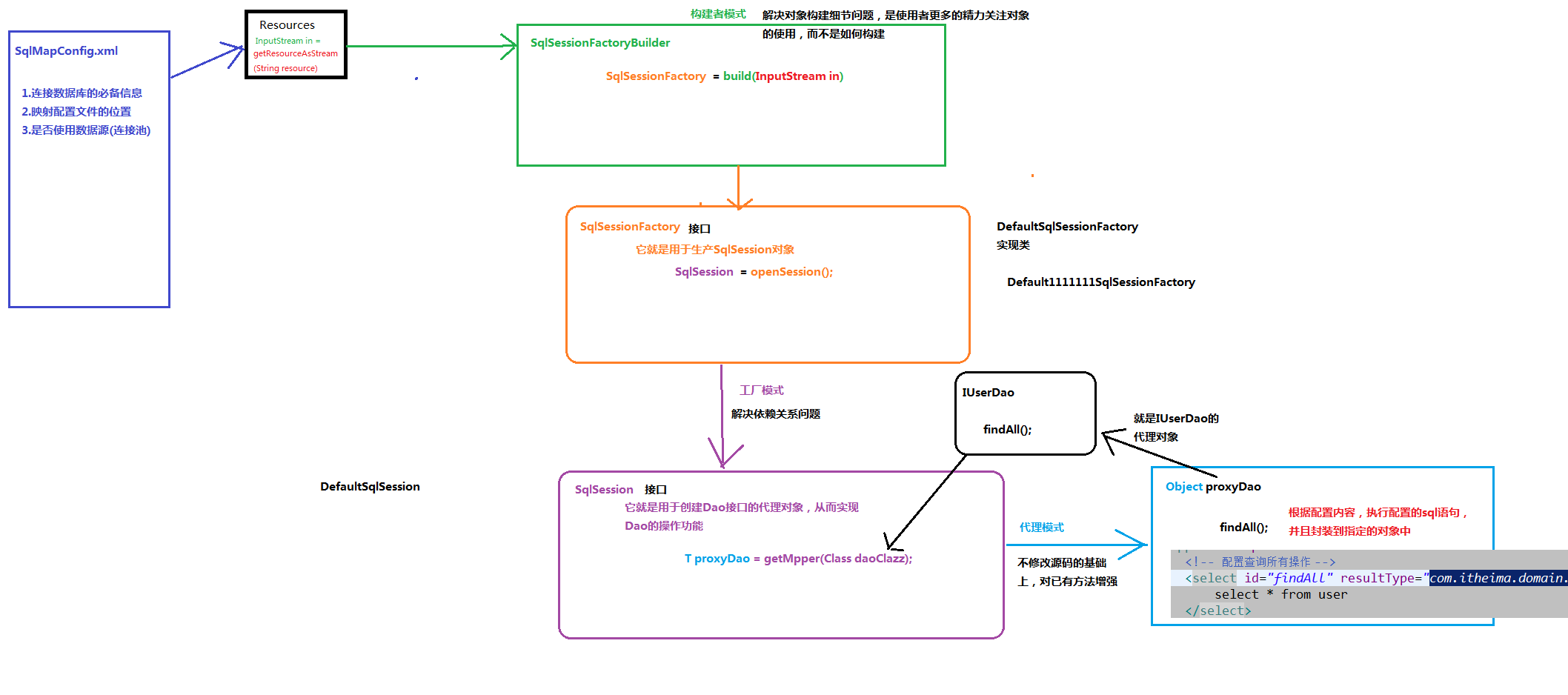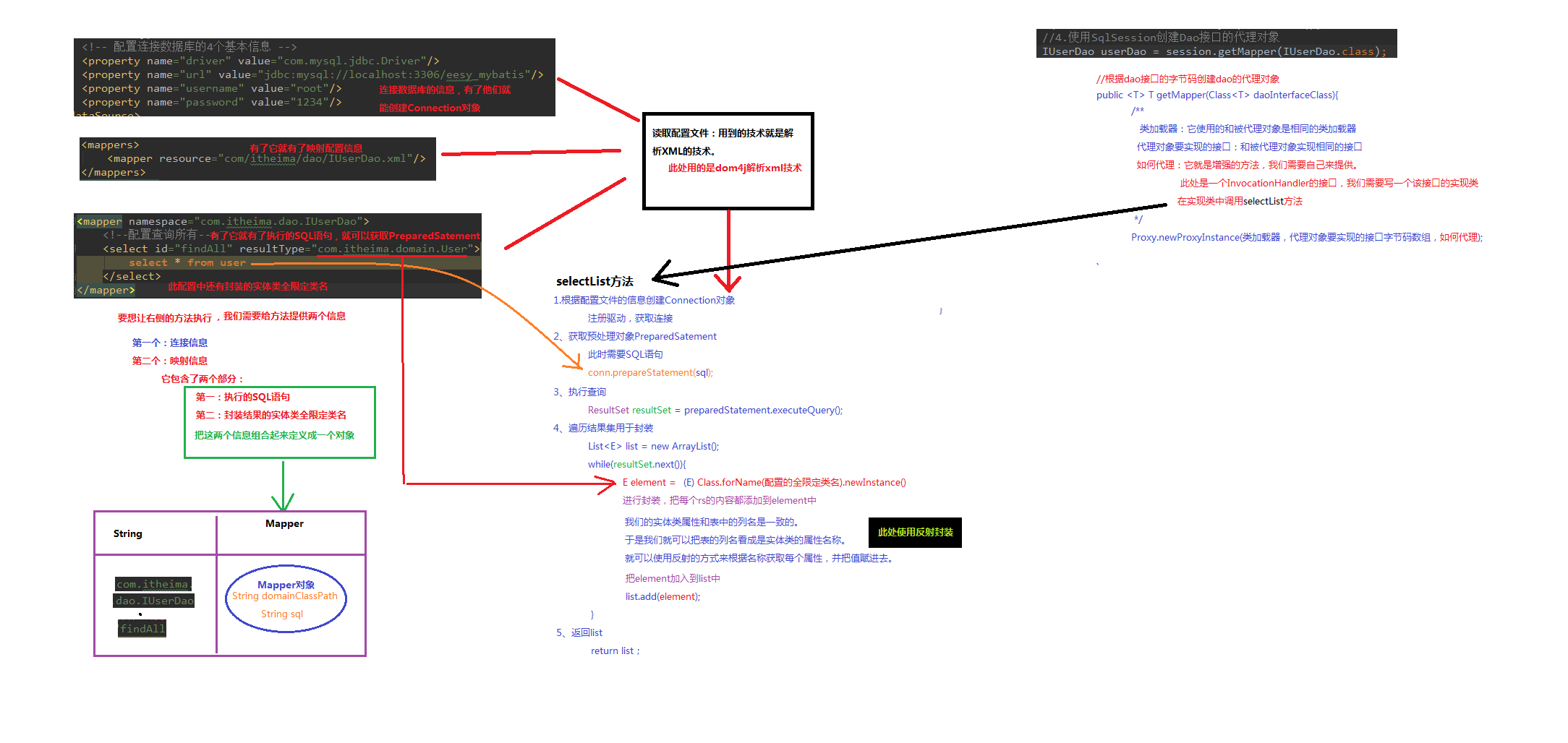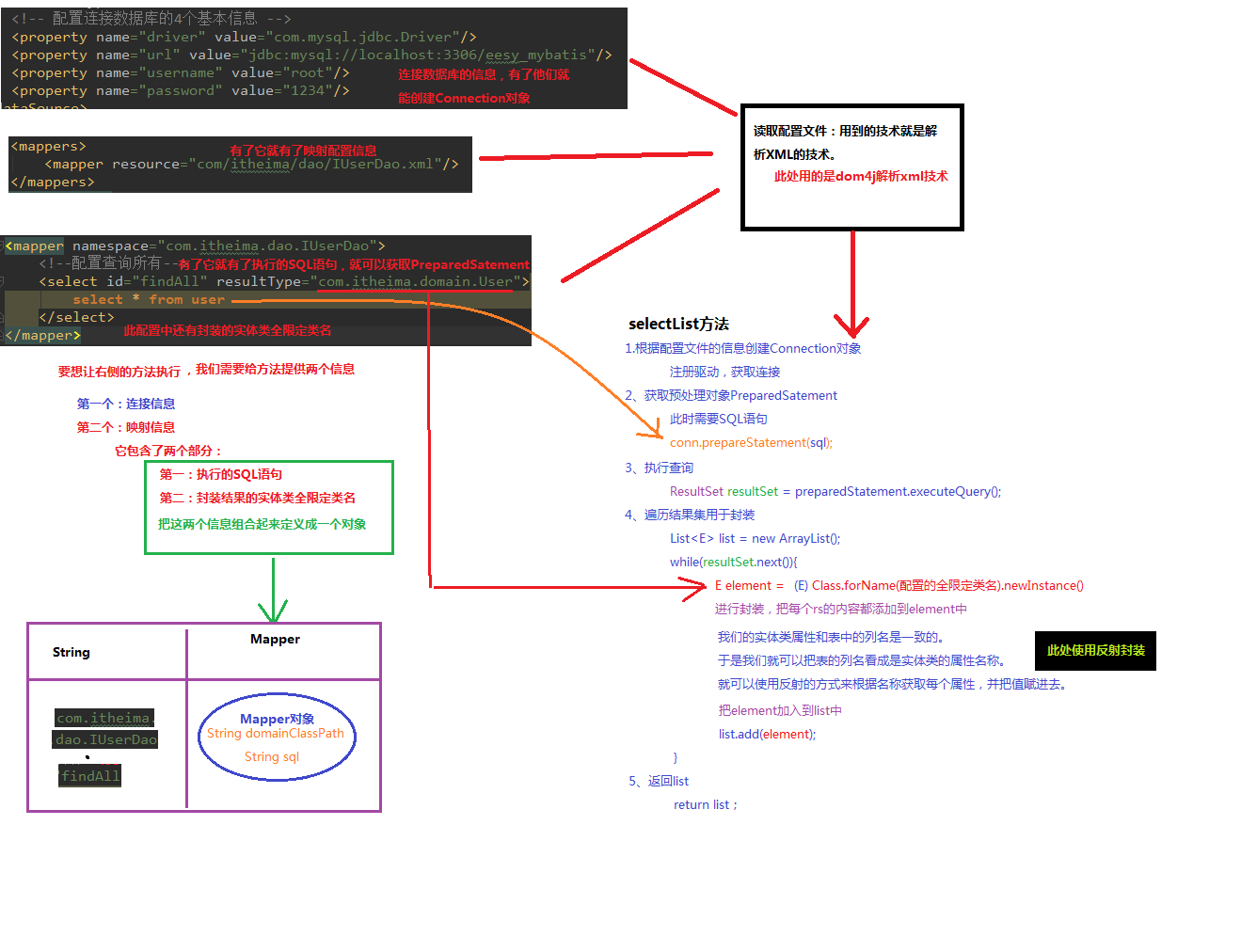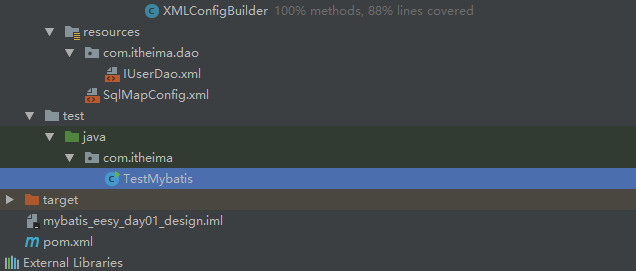自定义mybatis框架(1)
将会涉及到的一些知识点:工厂模式(Factory工厂模式)、构造者模式(Builder模式)、代理模式,反射,自定义注解,注解的反射,xml解析,
数据库元数据,元数据的反射等。
mybatis在使用代理dao的方式实现增删改查时做什么事呢?
只有两件事:
第一:创建代理对象
第二:在代理对象中调用selectList
自定义mybatis能通过入门案例看到类
class Resources
class SqlSessionFactoryBuilder
interface SqlSessionFactory
interface SqlSession
只有两件事:
第一:创建代理对象
第二:在代理对象中调用selectList
自定义mybatis能通过入门案例看到类
class Resources
class SqlSessionFactoryBuilder
interface SqlSessionFactory
interface SqlSession
1.分析流程
下面以图片进行展示



2.前期准备
2.1创建maven工程
2.2引入相关坐标、编写好包、接口、类的主要骨架
2.3引入工具类到项目
2.4编写SqlMapConfig.xml配置文件
2.5编写读取配置文件类
2.6编写Mapper类
2.7编写Configration配置类
3.基于xml的自定义mybatis框架(核心:解析主配置文件,把解析的内容传递到需要使用的地方,最后调用SelectList方法)
3.1自定义mybatis的结构


3.2代码实现
3.2.1实体类
package com.itheima.domain; import java.io.Serializable; import java.util.Date; public class User implements Serializable { private Integer id; private String username; private Date birthday; private String address; private String sex; public Integer getId() { return id; } public void setId(Integer id) { this.id = id; } public String getUsername() { return username; } public void setUsername(String username) { this.username = username; } public Date getBirthday() { return birthday; } public void setBirthday(Date birthday) { this.birthday = birthday; } public String getAddress() { return address; } public void setAddress(String address) { this.address = address; } public String getSex() { return sex; } public void setSex(String sex) { this.sex = sex; } @Override public String toString() { return "User{" + "id=" + id + ", username='" + username + '\'' + ", birthday=" + birthday + ", address='" + address + '\'' + ", sex='" + sex + '\'' + '}'; } }
3.2.2 IUserDao接口
package com.itheima.dao; import com.itheima.domain.User; import java.util.List; public interface IUserDao { // 查询所有用户 List<User> findAll(); }
3.2.3 mybatis主配置文件
<?xml version="1.0" encoding="UTF-8"?>
<configuration>
<!--配置mybatis的环境-->
<environments default="mysql">
<!--配置mysql的环境-->
<environment id="mysql">
<!--配置事务的类型-->
<transactionManager type="JDBC"></transactionManager>
<!--配置数据库的信息,用的是数据源(连接池技术)-->
<dataSource type="POOLED">
<property name="driver" value="com.mysql.jdbc.Driver"/>
<property name="url" value="jdbc:mysql://localhost:3306/eesy_mybatis"/>
<property name="username" value="root"/>
<property name="password" value="123"/>
</dataSource>
</environment>
</environments>
<!--告知mybatis映射文件的位置-->
<mappers>
<mapper resource="com/itheima/dao/IUserDao.xml"/>
</mappers>
</configuration>
3.2.4映射配置文件
<?xml version="1.0" encoding="UTF-8"?>
<mapper namespace="com.itheima.dao.IUserDao">
<select id="findAll" resultType="com.itheima.domain.User">
SELECT * FROM user
</select>
</mapper>
3.2.5 SqlSessionFactory接口
package com.itheima.mybatis.session; public interface SqlSessionFactory { SqlSession openSession(); }
3.2.6SqlSession接口
package com.itheima.mybatis.session; /** * 自定义mybatis中和数据库交互的核心类 * 它里面可以创建dao接口的代理对象 */ public interface SqlSession { /** * 根据参数创建一个接口的代理对象 * @param daoInterfaceClass * @param <T> * @return */ <T> T getMapper(Class<T> daoInterfaceClass ); /** * 关闭资源 */ void close(); }
3.2.7sqlSessionFactoryBuilder类
package com.itheima.mybatis.session; import com.itheima.mybatis.session.defaults.DefaultSqlSessionFactory; import com.itheima.mybatis.utils.XMLConfigBuilder; import com.itheima.mybatis.utils.cfg.Configuration; import java.io.InputStream; /** * 用于创建一个SqlSessionFactory对象 */ public class SqlSessionFactoryBuilder { /** * 根据字节输入流来构建一个SqlSessionFactory工厂 * 注意:因为涉及到了解析xml,并非此案例的重点,引入工具类 * @param config * @return */ public SqlSessionFactory build(InputStream config){ Configuration cfg = XMLConfigBuilder.loadConfiguration(config); return new DefaultSqlSessionFactory(cfg); } }
3.2.8.1 工具类(XMLConfigBuilder)
package com.itheima.mybatis.utils; //import com.itheima.mybatis.annotations.Select; import com.itheima.mybatis.io.Resources; import com.itheima.mybatis.utils.cfg.Configuration; import com.itheima.mybatis.utils.cfg.Mapper; import org.dom4j.Attribute; import org.dom4j.Document; import org.dom4j.Element; import org.dom4j.io.SAXReader; import java.io.IOException; import java.io.InputStream; import java.util.HashMap; import java.util.List; import java.util.Map; public class XMLConfigBuilder { /** * 解析主配置文件,把里面的内容填充到DefaultSqlSession所需要的地方 * 使用的技术: * dom4j+xpath */ public static Configuration loadConfiguration(InputStream config){ try{ //定义封装连接信息的配置对象(mybatis的配置对象) Configuration cfg = new Configuration(); //1.获取SAXReader对象 SAXReader reader = new SAXReader(); //2.根据字节输入流获取Document对象 Document document = reader.read(config); //3.获取根节点 Element root = document.getRootElement(); //4.使用xpath中选择指定节点的方式,获取所有property节点 List<Element> propertyElements = root.selectNodes("//property"); //5.遍历节点 for(Element propertyElement : propertyElements){ //判断节点是连接数据库的哪部分信息 //取出name属性的值 String name = propertyElement.attributeValue("name"); if("driver".equals(name)){ //表示驱动 //获取property标签value属性的值 String driver = propertyElement.attributeValue("value"); cfg.setDriver(driver); } if("url".equals(name)){ //表示连接字符串 //获取property标签value属性的值 String url = propertyElement.attributeValue("value"); cfg.setUrl(url); } if("username".equals(name)){ //表示用户名 //获取property标签value属性的值 String username = propertyElement.attributeValue("value"); cfg.setUsername(username); } if("password".equals(name)){ //表示密码 //获取property标签value属性的值 String password = propertyElement.attributeValue("value"); cfg.setPassword(password); } } //取出mappers中的所有mapper标签,判断他们使用了resource还是class属性 List<Element> mapperElements = root.selectNodes("//mappers/mapper"); //遍历集合 for(Element mapperElement : mapperElements){ //判断mapperElement使用的是哪个属性 Attribute attribute = mapperElement.attribute("resource"); if(attribute != null){ System.out.println("使用的是XML"); //表示有resource属性,用的是XML //取出属性的值 String mapperPath = attribute.getValue();//获取属性的值"com/itheima/dao/IUserDao.xml" //把映射配置文件的内容获取出来,封装成一个map Map<String,Mapper> mappers = loadMapperConfiguration(mapperPath); //给configuration中的mappers赋值 cfg.setMappers(mappers); }else{ /* System.out.println("使用的是注解"); //表示没有resource属性,用的是注解 //获取class属性的值 String daoClassPath = mapperElement.attributeValue("class"); //根据daoClassPath获取封装的必要信息 Map<String,Mapper> mappers = loadMapperAnnotation(daoClassPath); //给configuration中的mappers赋值 cfg.setMappers(mappers);*/ } } //返回Configuration return cfg; }catch(Exception e){ throw new RuntimeException(e); }finally{ try { config.close(); }catch(Exception e){ e.printStackTrace(); } } } /** * 根据传入的参数,解析XML,并且封装到Map中 * @param mapperPath 映射配置文件的位置 * @return map中包含了获取的唯一标识(key是由dao的全限定类名和方法名组成) * 以及执行所需的必要信息(value是一个Mapper对象,里面存放的是执行的SQL语句和要封装的实体类全限定类名) */ private static Map<String,Mapper> loadMapperConfiguration(String mapperPath)throws IOException { InputStream in = null; try{ //定义返回值对象 Map<String,Mapper> mappers = new HashMap<String,Mapper>(); //1.根据路径获取字节输入流 in = Resources.getResourceAsStream(mapperPath); //2.根据字节输入流获取Document对象 SAXReader reader = new SAXReader(); Document document = reader.read(in); //3.获取根节点 Element root = document.getRootElement(); //4.获取根节点的namespace属性取值 String namespace = root.attributeValue("namespace");//是组成map中key的部分 //5.获取所有的select节点 List<Element> selectElements = root.selectNodes("//select"); //6.遍历select节点集合 for(Element selectElement : selectElements){ //取出id属性的值 组成map中key的部分 String id = selectElement.attributeValue("id"); //取出resultType属性的值 组成map中value的部分 String resultType = selectElement.attributeValue("resultType"); //取出文本内容 组成map中value的部分 String queryString = selectElement.getText(); //创建Key String key = namespace+"."+id; //创建Value Mapper mapper = new Mapper(); mapper.setQueryString(queryString); mapper.setResultType(resultType); //把key和value存入mappers中 mappers.put(key,mapper); } return mappers; }catch(Exception e){ throw new RuntimeException(e); }finally{ in.close(); } } /** * 根据传入的参数,得到dao中所有被select注解标注的方法。 * 根据方法名称和类名,以及方法上注解value属性的值,组成Mapper的必要信息 * @param daoClassPath * @return private static Map<String,Mapper> loadMapperAnnotation(String daoClassPath)throws Exception{ //定义返回值对象 Map<String,Mapper> mappers = new HashMap<String, Mapper>(); //1.得到dao接口的字节码对象 Class daoClass = Class.forName(daoClassPath); //2.得到dao接口中的方法数组 Method[] methods = daoClass.getMethods(); //3.遍历Method数组 for(Method method : methods){ //取出每一个方法,判断是否有select注解 boolean isAnnotated = method.isAnnotationPresent(Select.class); if(isAnnotated){ //创建Mapper对象 Mapper mapper = new Mapper(); //取出注解的value属性值 Select selectAnno = method.getAnnotation(Select.class); String queryString = selectAnno.value(); mapper.setQueryString(queryString); //获取当前方法的返回值,还要求必须带有泛型信息 Type type = method.getGenericReturnType();//List<User> //判断type是不是参数化的类型 if(type instanceof ParameterizedType){ //强转 ParameterizedType ptype = (ParameterizedType)type; //得到参数化类型中的实际类型参数 Type[] types = ptype.getActualTypeArguments(); //取出第一个 Class domainClass = (Class)types[0]; //获取domainClass的类名 String resultType = domainClass.getName(); //给Mapper赋值 mapper.setResultType(resultType); } //组装key的信息 //获取方法的名称 String methodName = method.getName(); String className = method.getDeclaringClass().getName(); String key = className+"."+methodName; //给map赋值 mappers.put(key,mapper); } } return mappers; } */ }
3.2.8.2 工具类(Configration)
package com.itheima.mybatis.utils.cfg; import java.util.HashMap; import java.util.Map; public class Configuration { private String driver; private String url; private String username; private String password; private Map<String,Mapper> mappers = new HashMap<String,Mapper>(); public Map<String, Mapper> getMappers() { return mappers; } public void setMappers(Map<String, Mapper> mappers) { this.mappers.putAll(mappers);//此处需要使用追加的方式 } public String getDriver() { return driver; } public void setDriver(String driver) { this.driver = driver; } public String getUrl() { return url; } public void setUrl(String url) { this.url = url; } public String getUsername() { return username; } public void setUsername(String username) { this.username = username; } public String getPassword() { return password; } public void setPassword(String password) { this.password = password; } }
3.2.8.3工具类(Mapper)
package com.itheima.mybatis.utils.cfg; import java.util.Map; /** * 用于封装执行的SQL语句和 结果类型的全限定类名 */ public class Mapper { private String queryString;//执行的sql语句 private String resultType;//结果类型的全限定类名 public String getQueryString() { return queryString; } public void setQueryString(String queryString) { this.queryString = queryString; } public String getResultType() { return resultType; } public void setResultType(String resultType) { this.resultType = resultType; } }
3.2.8.4工具类(Executor)
package com.itheima.mybatis.utils; import com.itheima.mybatis.utils.cfg.Mapper; import java.beans.PropertyDescriptor; import java.lang.reflect.Method; import java.sql.Connection; import java.sql.PreparedStatement; import java.sql.ResultSet; import java.sql.ResultSetMetaData; import java.util.ArrayList; import java.util.List; public class Executor { public <E> List<E> selectList(Mapper mapper, Connection conn) { PreparedStatement pstm = null; ResultSet rs = null; try { //1.取出mapper中的数据 String queryString = mapper.getQueryString();//select * from user String resultType = mapper.getResultType();//com.itheima.domain.User Class domainClass = Class.forName(resultType); //2.获取PreparedStatement对象 pstm = conn.prepareStatement(queryString); //3.执行SQL语句,获取结果集 rs = pstm.executeQuery(); //4.封装结果集 List<E> list = new ArrayList<E>();//定义返回值 while(rs.next()) { //实例化要封装的实体类对象 E obj = (E)domainClass.newInstance(); //取出结果集的元信息:ResultSetMetaData ResultSetMetaData rsmd = rs.getMetaData(); //取出总列数 int columnCount = rsmd.getColumnCount(); //遍历总列数 for (int i = 1; i <= columnCount; i++) { //获取每列的名称,列名的序号是从1开始的 String columnName = rsmd.getColumnName(i); //根据得到列名,获取每列的值 Object columnValue = rs.getObject(columnName); //给obj赋值:使用Java内省机制(借助PropertyDescriptor实现属性的封装) PropertyDescriptor pd = new PropertyDescriptor(columnName,domainClass);//要求:实体类的属性和数据库表的列名保持一种 //获取它的写入方法 Method writeMethod = pd.getWriteMethod(); //把获取的列的值,给对象赋值 writeMethod.invoke(obj,columnValue); } //把赋好值的对象加入到集合中 list.add(obj); } return list; } catch (Exception e) { throw new RuntimeException(e); } finally { release(pstm,rs); } } private void release(PreparedStatement pstm,ResultSet rs){ if(rs != null){ try { rs.close(); }catch(Exception e){ e.printStackTrace(); } } if(pstm != null){ try { pstm.close(); }catch(Exception e){ e.printStackTrace(); } } } }
3.2.8.5 工具类(DataSourceUtils)
package com.itheima.mybatis.utils; import com.itheima.mybatis.utils.cfg.Configuration; import java.sql.Connection; import java.sql.DriverManager; /** * 用于创建数据源的工具类 */ public class DataSourceUtils { /** * 用于获取一个连接 * @param cfg * @return */ public static Connection getConnection(Configuration cfg){ try { Class.forName(cfg.getDriver()); return DriverManager.getConnection(cfg.getUrl(), cfg.getUsername(), cfg.getPassword()); }catch (Exception e){ throw new RuntimeException(e); } } }
3.2.9 DefaultSqlSessionFactory类(SqlSessionFactory的实现类)
package com.itheima.mybatis.session.defaults; import com.itheima.mybatis.session.SqlSession; import com.itheima.mybatis.session.SqlSessionFactory; import com.itheima.mybatis.utils.cfg.Configuration; /** * sqlSessionFactory的实现类 */ public class DefaultSqlSessionFactory implements SqlSessionFactory { private Configuration cfg; public DefaultSqlSessionFactory(Configuration cfg){ this.cfg = cfg; } /** * 用于创建一个新的操作数据库对象 * @return */ @Override public SqlSession openSession() { return new DefaultSqlSession(cfg); } }
3.2.10 DefaultSqlSession类(SqlSession的实现类)
package com.itheima.mybatis.session.defaults; import com.itheima.mybatis.session.SqlSession; import com.itheima.mybatis.session.proxy.MapperProxy; import com.itheima.mybatis.utils.DataSourceUtils; import com.itheima.mybatis.utils.cfg.Configuration; import java.lang.reflect.Proxy; import java.sql.Connection; public class DefaultSqlSession implements SqlSession { private Configuration cfg; private Connection connection; public DefaultSqlSession(Configuration cfg){ this.cfg = cfg; connection = DataSourceUtils.getConnection(cfg); } /** * 用于创建代理对象 * @param daoInterfaceClass * @param <T> * @return */ @Override public <T> T getMapper(Class<T> daoInterfaceClass) { return (T) Proxy.newProxyInstance(daoInterfaceClass.getClassLoader(), new Class[]{daoInterfaceClass}, new MapperProxy(cfg.getMappers(),connection)); } @Override public void close() { if(connection!=null) { try { connection.close(); } catch (Exception e) { e.printStackTrace(); } } } }
3.2.11 MapperProxy类(怎样代理)
package com.itheima.mybatis.session.proxy; import com.itheima.mybatis.utils.Executor; import com.itheima.mybatis.utils.cfg.Mapper; import java.lang.reflect.InvocationHandler; import java.lang.reflect.Method; import java.sql.Connection; import java.util.Map; public class MapperProxy implements InvocationHandler { //map的key是全限定类名+方法名 private Map<String,Mapper> mappers; private Connection conn; public MapperProxy(Map<String,Mapper> mappers,Connection conn){ this.mappers = mappers; this.conn = conn; } /** * 用于对方法进行增强的,我们的增强其实就是调用selectList方法 * 此方法要执行,得从参数中拿出sql语句,得拿出映射信息,使用构造器传参 * @param proxy * @param method * @param args * @return * @throws Throwable */ @Override public Object invoke(Object proxy, Method method, Object[] args) throws Throwable { //1.获取方法名 String methodName = method.getName(); //2.获取方法所在类的名称 String className = method.getDeclaringClass().getName(); //3.组合key String key = className+"."+methodName; //4.获取mappers中的Mapper对象 Mapper mapper = mappers.get(key); //5.判断是否有mapper if(mapper == null){ throw new IllegalArgumentException("传入的参数有误"); } //6.调用工具类执行查询所有 return new Executor().selectList(mapper,conn); } }
3.2.12 Resources类
package com.itheima.mybatis.io; import java.io.InputStream; /** * 使用配置文件读取文件夹的类 */ public class Resources { /** * 根据传入的参数,获取一个字节输入流 * @param filepath * @return */ public static InputStream getResourceAsStream(String filepath){ return Resources.class.getClassLoader().getResourceAsStream(filepath); } }
3.2.13测试类
package com.itheima; import com.itheima.dao.IUserDao; import com.itheima.domain.User; import com.itheima.mybatis.io.Resources; import com.itheima.mybatis.session.SqlSession; import com.itheima.mybatis.session.SqlSessionFactory; import com.itheima.mybatis.session.SqlSessionFactoryBuilder; import java.io.IOException; import java.io.InputStream; import java.util.List; public class TestMybatis { public static void main(String[] args) throws IOException { //1.读取配置文件 InputStream in = Resources.getResourceAsStream("SqlMapConfig.xml"); //2.创建SqlSessionFactory的构建者对象 SqlSessionFactoryBuilder builder = new SqlSessionFactoryBuilder(); //3.使用构建者创建工厂对象SqlSessionFactory SqlSessionFactory factory = builder.build(in); //4.使用SqlSessionFactory创建SqlSession对象 SqlSession sqlSession = factory.openSession(); //5.使用SqlSession创建dao的代理对象 IUserDao userDao = sqlSession.getMapper(IUserDao.class); //6.使用代理对象执行查询方法 List<User> userList = userDao.findAll(); for (User user :userList){ System.out.println(user.toString()); } //7.释放资源 sqlSession.close(); in.close(); } }
3.3 测试结果
使用的是XML User{id=41, username='老王', birthday=2018-02-27 17:47:08.0, address='北京', sex='男'} User{id=42, username='小二王', birthday=2018-03-02 15:09:37.0, address='北京金燕龙', sex='女'} User{id=43, username='小二王', birthday=2018-03-04 11:34:34.0, address='北京金燕龙', sex='女'} User{id=45, username='传智播客', birthday=2018-03-04 12:04:06.0, address='北京金燕龙', sex='男'} User{id=46, username='老王', birthday=2018-03-07 17:37:26.0, address='北京', sex='男'} User{id=48, username='小马宝莉', birthday=2018-03-08 11:44:00.0, address='北京修正', sex='女'}
4.1基于注解的自定义mybatis
改动地点
4.2.1SqlMapConfig主配置文件
<!--告知mybatis映射文件的位置-->
<mappers>
<mapper class="com.itheima.dao.IUserDao"/>
<!--
<mapper resource="com/itheima/dao/IUserDao.xml"/>
-->
</mappers>
</configuration>
4.2.2IUserDao映射配置文件
package com.itheima.dao; import com.itheima.domain.User; import java.util.List; public interface IUserDao { // 查询所有用户 @Select("select * from user") List<User> findAll(); }
4.2.3 自定义Select注解
package com.itheima.dao; import java.lang.annotation.ElementType; import java.lang.annotation.Retention; import java.lang.annotation.RetentionPolicy; import java.lang.annotation.Target; /** * 查询的注解 */ @Retention(RetentionPolicy.RUNTIME)//注解的生命周期为运行时 @Target(ElementType.METHOD)//出现的位置 public @interface Select { String value();//用于接收Sql语句 }
4.2.4 基于注解的工具类(XMLConfigBuilder)
package com.itheima.mybatis.utils; import com.itheima.dao.Select; import com.itheima.mybatis.io.Resources; import com.itheima.mybatis.utils.cfg.Configuration; import com.itheima.mybatis.utils.cfg.Mapper; import org.dom4j.Attribute; import org.dom4j.Document; import org.dom4j.Element; import org.dom4j.io.SAXReader; import java.io.IOException; import java.io.InputStream; import java.lang.reflect.Method; import java.lang.reflect.ParameterizedType; import java.lang.reflect.Type; import java.util.HashMap; import java.util.List; import java.util.Map; public class XMLConfigBuilder { /** * 解析主配置文件,把里面的内容填充到DefaultSqlSession所需要的地方 * 使用的技术: * dom4j+xpath */ public static Configuration loadConfiguration(InputStream config){ try{ //定义封装连接信息的配置对象(mybatis的配置对象) Configuration cfg = new Configuration(); //1.获取SAXReader对象 SAXReader reader = new SAXReader(); //2.根据字节输入流获取Document对象 Document document = reader.read(config); //3.获取根节点 Element root = document.getRootElement(); //4.使用xpath中选择指定节点的方式,获取所有property节点 List<Element> propertyElements = root.selectNodes("//property"); //5.遍历节点 for(Element propertyElement : propertyElements){ //判断节点是连接数据库的哪部分信息 //取出name属性的值 String name = propertyElement.attributeValue("name"); if("driver".equals(name)){ //表示驱动 //获取property标签value属性的值 String driver = propertyElement.attributeValue("value"); cfg.setDriver(driver); } if("url".equals(name)){ //表示连接字符串 //获取property标签value属性的值 String url = propertyElement.attributeValue("value"); cfg.setUrl(url); } if("username".equals(name)){ //表示用户名 //获取property标签value属性的值 String username = propertyElement.attributeValue("value"); cfg.setUsername(username); } if("password".equals(name)){ //表示密码 //获取property标签value属性的值 String password = propertyElement.attributeValue("value"); cfg.setPassword(password); } } //取出mappers中的所有mapper标签,判断他们使用了resource还是class属性 List<Element> mapperElements = root.selectNodes("//mappers/mapper"); //遍历集合 for(Element mapperElement : mapperElements){ //判断mapperElement使用的是哪个属性 Attribute attribute = mapperElement.attribute("resource"); if(attribute != null){ System.out.println("使用的是XML"); //表示有resource属性,用的是XML //取出属性的值 String mapperPath = attribute.getValue();//获取属性的值"com/itheima/dao/IUserDao.xml" //把映射配置文件的内容获取出来,封装成一个map Map<String,Mapper> mappers = loadMapperConfiguration(mapperPath); //给configuration中的mappers赋值 cfg.setMappers(mappers); }else{ System.out.println("使用的是注解"); //表示没有resource属性,用的是注解 //获取class属性的值 String daoClassPath = mapperElement.attributeValue("class"); //根据daoClassPath获取封装的必要信息 Map<String,Mapper> mappers = loadMapperAnnotation(daoClassPath); //给configuration中的mappers赋值 cfg.setMappers(mappers); } } //返回Configuration return cfg; }catch(Exception e){ throw new RuntimeException(e); }finally{ try { config.close(); }catch(Exception e){ e.printStackTrace(); } } } /** * 根据传入的参数,解析XML,并且封装到Map中 * @param mapperPath 映射配置文件的位置 * @return map中包含了获取的唯一标识(key是由dao的全限定类名和方法名组成) * 以及执行所需的必要信息(value是一个Mapper对象,里面存放的是执行的SQL语句和要封装的实体类全限定类名) */ private static Map<String,Mapper> loadMapperConfiguration(String mapperPath)throws IOException { InputStream in = null; try{ //定义返回值对象 Map<String,Mapper> mappers = new HashMap<String,Mapper>(); //1.根据路径获取字节输入流 in = Resources.getResourceAsStream(mapperPath); //2.根据字节输入流获取Document对象 SAXReader reader = new SAXReader(); Document document = reader.read(in); //3.获取根节点 Element root = document.getRootElement(); //4.获取根节点的namespace属性取值 String namespace = root.attributeValue("namespace");//是组成map中key的部分 //5.获取所有的select节点 List<Element> selectElements = root.selectNodes("//select"); //6.遍历select节点集合 for(Element selectElement : selectElements){ //取出id属性的值 组成map中key的部分 String id = selectElement.attributeValue("id"); //取出resultType属性的值 组成map中value的部分 String resultType = selectElement.attributeValue("resultType"); //取出文本内容 组成map中value的部分 String queryString = selectElement.getText(); //创建Key String key = namespace+"."+id; //创建Value Mapper mapper = new Mapper(); mapper.setQueryString(queryString); mapper.setResultType(resultType); //把key和value存入mappers中 mappers.put(key,mapper); } return mappers; }catch(Exception e){ throw new RuntimeException(e); }finally{ in.close(); } } /** * 根据传入的参数,得到dao中所有被select注解标注的方法。 * 根据方法名称和类名,以及方法上注解value属性的值,组成Mapper的必要信息 * @param daoClassPath * @return */ private static Map<String,Mapper> loadMapperAnnotation(String daoClassPath)throws Exception{ //定义返回值对象 Map<String,Mapper> mappers = new HashMap<String, Mapper>(); //1.得到dao接口的字节码对象 Class daoClass = Class.forName(daoClassPath); //2.得到dao接口中的方法数组 Method[] methods = daoClass.getMethods(); //3.遍历Method数组 for(Method method : methods){ //取出每一个方法,判断是否有select注解 boolean isAnnotated = method.isAnnotationPresent(Select.class); if(isAnnotated){ //创建Mapper对象 Mapper mapper = new Mapper(); //取出注解的value属性值 Select selectAnno = method.getAnnotation(Select.class); String queryString = selectAnno.value(); mapper.setQueryString(queryString); //获取当前方法的返回值,还要求必须带有泛型信息 Type type = method.getGenericReturnType();//List<User> //判断type是不是参数化的类型 if(type instanceof ParameterizedType){ //强转 ParameterizedType ptype = (ParameterizedType)type; //得到参数化类型中的实际类型参数 Type[] types = ptype.getActualTypeArguments(); //取出第一个 Class domainClass = (Class)types[0]; //获取domainClass的类名 String resultType = domainClass.getName(); //给Mapper赋值 mapper.setResultType(resultType); } //组装key的信息 //获取方法的名称 String methodName = method.getName(); String className = method.getDeclaringClass().getName(); String key = className+"."+methodName; //给map赋值 mappers.put(key,mapper); } } return mappers; } }
4.3 测试类
package com.itheima; import com.itheima.dao.IUserDao; import com.itheima.domain.User; import com.itheima.mybatis.io.Resources; import com.itheima.mybatis.session.SqlSession; import com.itheima.mybatis.session.SqlSessionFactory; import com.itheima.mybatis.session.SqlSessionFactoryBuilder; import java.io.IOException; import java.io.InputStream; import java.util.List; public class TestMybatis { public static void main(String[] args) throws IOException { //1.读取配置文件 InputStream in = Resources.getResourceAsStream("SqlMapConfig.xml"); //2.创建SqlSessionFactory的构建者对象 SqlSessionFactoryBuilder builder = new SqlSessionFactoryBuilder(); //3.使用构建者创建工厂对象SqlSessionFactory SqlSessionFactory factory = builder.build(in); //4.使用SqlSessionFactory创建SqlSession对象 SqlSession sqlSession = factory.openSession(); //5.使用SqlSession创建dao的代理对象 IUserDao userDao = sqlSession.getMapper(IUserDao.class); //6.使用代理对象执行查询方法 List<User> userList = userDao.findAll(); for (User user :userList){ System.out.println(user.toString()); } //7.释放资源 sqlSession.close(); in.close(); } }
4.4 运行结果
使用的是注解 User{id=41, username='老王', birthday=2018-02-27 17:47:08.0, address='北京', sex='男'} User{id=42, username='小二王', birthday=2018-03-02 15:09:37.0, address='北京金燕龙', sex='女'} User{id=43, username='小二王', birthday=2018-03-04 11:34:34.0, address='北京金燕龙', sex='女'} User{id=45, username='传智播客', birthday=2018-03-04 12:04:06.0, address='北京金燕龙', sex='男'} User{id=46, username='老王', birthday=2018-03-07 17:37:26.0, address='北京', sex='男'} User{id=48, username='小马宝莉', birthday=2018-03-08 11:44:00.0, address='北京修正', sex='女'} Process finished with exit code 0



 浙公网安备 33010602011771号
浙公网安备 33010602011771号